- Know about the Ghorpades, the brave Sanataji and Murarrao amongst others, and their wars in South India primarily Karnataka. Santaji attacked Aurangzeb's personal tent at Koregaon in July 1689.
Part 1 on the Ghorpades was about Santaji
Ghorpade and the Battle of Dodderi – defeat of the Mughals. Here is part 2.
The
sabers of Ghorpades were like the jaws of death,
They
are like a snake chasing you everywhere,
They won’t return to the scabbard
Unless
they annihilate you, O Mughals, Beware.
In the early 14th Century,
Sujan Singh, who was associated with Royal family of Mewar came to Deccan and
settled in Maharashtra. His family flourished in the Bahamani Kingdom that was
founded in the 14th Century.
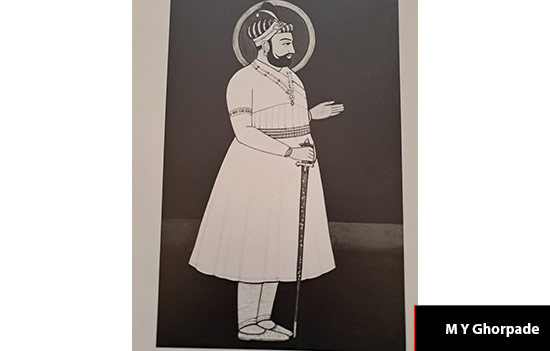 Sujan Singh. Credits 1.
Sujan Singh. Credits 1.
How Ghorpade got their surname is very
interesting story.
In the 15th century, while
capturing Khelna (Vishalgad fort), Karna Singh used a monitor lizard to scale
the fort walls, made a surprise attack on fort garrison and captured it. For his
bravery, the then Bahmani King gave Karna Singh a large jagir (fief), the title
Raja Ghorpade and his own flag (Black & white-the same color as monitor
lizard). Later, the title became the surname for one of the branches of Sujan
Singh.
 Ghorpade flag. Credits 2.
Ghorpade flag. Credits 2.
After destruction of Nizamshahi due to the joint attack of Shah Jahan and Muhammad Adil Shah in 1636, Shahaji Raje Bhonsle (father of Shivaji) joined Adil Shah of Bijapur. Adil Shah deliberately posted him at Bangalore to sever him from the mountainous Sahyadri which were effectively used to wage guerilla warfare.
In the feud for the family jagir (fief) of Ghorpade’s, Baji Ghorpade became dominant and he took the share which was allocated to his younger cousin Mhaloji Ghorpade. Shahaji Bhonsle, who became prime noble in Adilshahi court, influenced Adilshah to split the fief so as to give Mhaloji his due share in 1637. This decision changed the course of events as Baji became a sworn enemy of the Shahaji Bhonsle whereas Mhaloji became his ardent supporter.
Taking Revenge
After 1646, when Shivaji Raje started capturing the forts and areas like Torna, Sinhgad, Supa, Chakan, Muhammad Adil Shah decided to crush this revolt. But he was worried about the reaction of Shahaji Raje, who might also have revolted after hearing the news of the campaign against his son. Hence, he first decided to capture Shahaji Raje and pressure his sons into submission. The raid to capture Shahaji Raje was planned by Mustafa Khan (C-in-C Bijapur) during the siege of Gingee but the actual raid was executed by Baji Ghorpade who was already looking for a score to settle with Shahaji Raje (support to Mhaloji for the separate fief). He and other Bijapuri nobles attacked Shahaji Raje’s camp and captured him after a bitter battle. The third person in this saga was Afzal Khan who took Shahaji Raje from Gingee to Bijapur and humiliated him by parading a bound Shahaji Raje atop an elephant through the streets of Bijapur.
Hence, Shivaji Raje had to combine Military victory over Bijapur Generals as both Fateh Khan (Battle of Purandar) and Farhad Khan (Battle of Bangalore) were defeated by Shivaji Raje and his older brother Sambhaji Raje respectively) as well as brilliant diplomatic manoeuvring (pretending to join Mughals) and pressured Adil Shah to release Shahji Raje from the dungeons of Bijapur (1648-49).
Out of these three persons, Mustafa Khan died of a natural death due to
old age shortly but Afzal Khan (Battle of Pratapgad-1659) and Baji Ghorpade
(Battle of Mudhol-1664) were personally killed by Shivaji Raje to avenge the
insult of his father and death of his older brother.
Early years of Swarajya
The movement of Hindavi Swarajya was under planning for
long. Papers with the title Chhatrapati indicate that a small cohesive
independent State with ministers and officials with definitive duties came into
being around 1653, although the final shape took many years to be completed.
Apart from civilian officers like Dadoji Kondadev administering the fief from 1637, the young Shivaji Raje returned from Bangalore to Pune in 1642-43 with officers appointed by his father Shahaji Bhonsle. When Shivaji Maharaj took control from 1645 onwards, Shahaji sent him experienced and influential officers in small numbers as a mass exodus would have exposed his covert and crucial support to his son in front of his enemies at the Adilshahi court.
Like Kanhoji Jedhe who left on the
instructions of Shahaji in 1650, Mhaloji Ghorpade also returned to Hindavi Swarajya in 1653-54. He became
one of the most trusted generals of Shivaji Maharaj and had the rare
distinction to serve from Shahaji to Chhatrapati Sambhaji. His sons Santaji,
Bahirji, and Maloji also joined the Maratha force and started rising in the
ranks while learning strategy and tactics from stalwarts like Senapati
Prataprao Gujar and later Hambirrao Mohite.
Battle of Yelburga (1677)
was one of the earliest engagements fought during the Southern Conquest of
Chhatrapati Shivaji in which Ghorpade brothers showed tremendous courage while
blunting the sudden attack of Miyana brothers of Koppal (Adilshahi). The rout
of Bijapur forces opened the door for further conquests by the Marathas in the Krishna-Godavari
basin.
After death of Chhatrapati Shivaji in 1680, his son Sambaji ascended the throne. Ghorpade brothers along with Dhanaji Jadhav were the rising stars in the Maratha army’s ranks due to their bravery in halting the Mughal onslaught.
In 1685-86, Chhatrapati Sambaji sent Keso
Trimal and Santaji to Gingee to reinforce his brother-in-law Haraji Mahadik. However,
Santaji was recalled in 1687 as after fall of Adilshahi (Bijapur) and Qutubshahi
(Golconda), as the Mughal might would be arrayed against the Maratha Empire.
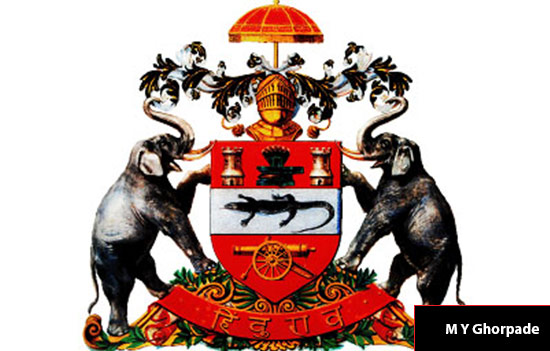 Logo of Sandur Royal Family. Credits 1.
Logo of Sandur Royal Family. Credits 1.
Full caption - At the very top of logo is a royal canopy “Chatr”. Heart of the logo is a Shivalingam with two temples on the either side, a monitor lizard and a canon, sword, with a shield. Bottom is ‘Hindu Rao’. Centre is supported by elephants on either side. Pic courtesy Shivavilas Palace Hotel Sandur, Karnataka.
Veergati
Though Marathas won the Battle of Wai (1687) and routed Sharza Khan’s forces, the death of Hambirrao Mohite was a tremendous jolt. Now Mhaloji Ghorpade became the Commander-in-Chief and was appointed at Panhala to guard Southwestern approaches to the Maratha Empire. He attained martyrdom in the Battle of Sangameshwar while trying to save Chhatrapati Sambaji from Muqarrab Khan in 1689.
After the brutal torture and execution of
Chhatrapati Sambhaji, Aurangzeb sent Itiqad Khan (retitled Zulfiqar Khan) to
besiege Raigad. Maharani Yesubai decided to remain back at the fort while
Rajaram Maharaj moved towards Gingee.
Audacious
Plan
Santaji decided to take revenge for the brutal execution of Chhatrapati Sambhaji and made a surprise attack on the Mughal camp at Koregaon (July 1689). Aurangzeb ran into the Janana tents (ladies’ quarters) to save himself. Since there was not much time to pursue him, Santaji decided to call off the attack but only after demolishing the Royal tent and taking three golden pinnacles as a sign of victory. The attack on his personal tent gave a
signal to Aurangzeb that victory over the Marathas was still distant.
From 1689 till his death in 1697, Senapati
Santaji along with Dhanaji Jadhav, Ramchandrapant Amatya, and Shankaraji
Narayan Sachiv created a storm and fought against Mughal forces, from Burhanpur
(MP) to Gingee (TN).
Battle of Kolhapur
When Rajaram Maharaj started his march
towards Gingee (October 1689), to divert the attention of the Mughal forces,
Santaji attacked the camp of Muqarrab Khan at Kolhapur and defeated him. Muqarrab Khan and his son Ikhlas
Khan were severely wounded and barely escaped alive.
Battle
of Varada-Tungabhadra
As per directive from Aurangzeb, Mughal
officers in Karnataka started pursuing the entourage of Rajaram Maharaj. Two
fierce battles were fought by the Marathas on the banks of River Varada and
Tungabhdra to clear the passage of Rajaram Maharaj.
In Tungabhadra encounter, Maloji, the
youngest of Ghorpade brothers impersonated Rajaram Maharaj and surrendered
himself while Bahirji (2nd brother) swam away with real one, crossed Tungabhdra and reached the area controlled by Keladi Chenamma. Maloji was later executed on the orders of Aurangzeb, thus Ghorpade’s lost two persons (Mhaloji and Maloji) within a year.
Battle
of Keladi
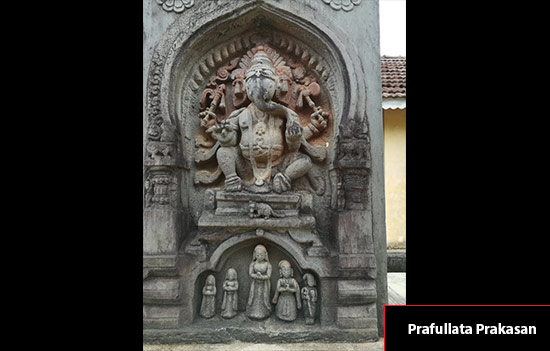 Keladi Chenamma & Rajaram Maharaj at Rameshwaram Temple Keladi. Credits 2.
Keladi Chenamma & Rajaram Maharaj at Rameshwaram Temple Keladi. Credits 2.
When Aurangzeb came to know that Chenamma,
the queen of Keladi had helped Rajaram Maharaj escape from his clutches, he
sent Prince Azam to subdue her. But Maratha forces under Santaji reached Keladi
in time and the forces of Matlab Khan (Ikkeri), Sharza Khan (Keladi), and Jannisar
Khan (Kavaledurga) were routed by the joint Maratha-Keladi forces (late 1689).
Defeat
of Sharza Khan
In April 1690, Maratha forces attacked Sharza Khan, who had besieged
Satara fort. First, he was lured away from the camp on the pretext of chasing
the fleeing Marathas attacking his camp. Next he was brought to a field where
his forces were trapped on all sides by Marathas and decisively defeated.
Meanwhile, the Mughal camp which only a token force was guarding was attacked
and destroyed by the Maratha garrison in the fort. Sharza Khan with his son
Ghalib and other family members were made Prisoners-of-war.
Lifting
the siege of Gingee
In late 1692 Maratha forces attacked Zulfiqar Khan besieging Gingee by cutting off his supplies thus it became difficult for him to continue the siege. Santaji and Dhanaji were able to create a pincer movement and Zulfiqar had to fight his way out but ‘Isma‘il Khan Makha, was captured and imprisoned for the next two years.
Battle
of Dodderi & Basavapattana
Battle of Dodderi was, one of the finest
specimens of guerilla tactics and traditional cavalry tactics, fought on an
open plain. To read about battle click Here
Siege
of Gingee
Bahirji Ghorpade was appointed as the Killedar (fort commander) of Gingee by
Chhatrapati Rajaram in 1690. He fought with exemplary courage and Zulfiqar Khan
the prime noble tasked with capture of Gingee had to spend more than 7.5 years
of his life taking this fort. The siege of Gingee was one of the
longest-running sieges in history but at least twice, Zulfiqar Khan was forced
to lift it due to Maratha attacks and his dwindling military and supplies.
Bahirji thus received the title Hindurao from Chhatrapati Rajaram. The
fort was captured only after the Chhatrapati Rajaram and other important
Maratha nobles had left for Vellore and later to Maharashtra in 1698.
Attack on Burhanpur (about two hour’s drive south of Indore)
In January 1695, Santaji attacked and looted Aurangabad Subha, fear of his name and the prospect of Maratha captivity was so dreadful that Abdul Gafur (Ahmednagar) and Inayat Khan (Aurangabad) didn’t even come out of their forts to resist.
Santaji immediately turned towards Burhanpur which was a major commercial center and supply base for Mughal’s fighting in Deccan. Marhamat Khan, Subhedar of Burhanpur was defeated in brief but intense battle, but he was able to escape in the nick of time. He locked himself up in the fortress and came out only when Maratha army looted and left the city as smoking ruins.
Senapati Santaji’s forces defeated many major Mughal nobles like Ali Mardan Khan (Battle of
Kanchi-December 1692), Jannisar Khan and Tahawwuvr Khan (Battle of Raibag-Hukkeri-June
1691).
Khafi Khan grudgingly acknowledges the contribution of Santaji in Maratha-Mughal war, “Santa more especially distinguished himself in ravaging the cultivated districts and attacking the royal leaders. Everyone who encountered him was either killed or wounded and made prisoner or if anyone did escape, it was with his mere life, with the loss of his army and baggage Nothing could be done, for wherever the accursed dog went and threatened an attack, there was no Imperial amir bold enough to resist him, and every loss he inflicted on their forces made the boldest warriors’ quake.”
Mughal akhbars and contemporary books like
Maasir-i-Alamgiri have dedicated pages after pages to the defeats faced
by Mughals due to Santaji all across Deccan. They also reveal how, many premier
nobles like Himmat Khan, Nahar Khan, Hamiduddin Khan, Ghaziuddin Khan, were
continuously trying to defeat Santaji and Dhanaji without any success.
When it became almost difficult to defeat
Santaji in battle, Aurangzeb approved his assassination by any means. Nagoji
Mane, a Maratha nobleman who had deserted the Mughal army of Zulfiqar Khan
during the siege of Ginjee in 1690 and was planning again to switch sides.
Aurangzeb was ready to approve a new fief (jagir) in Varhad along with the old
fief and other demands of Nagoji Mane only on one condition capture or
execution of Santaji.
The troops of Bidar Bakht, Ghaziuddin Firoz
Jung, Hamiduddin Khan, Matlab Khan all failed to find Santaji when he was living
in exile in Shambhu Mahadeo Hills. Hence, Aurangzeb was searching for a Maratha
noble who could locate Santaji.
The
Assassination
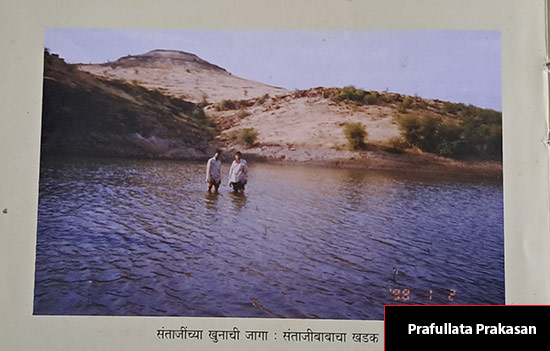 Karkhel, the place where Santaji was killed. Credit 2.
Karkhel, the place where Santaji was killed. Credit 2.
The matter of locating Santaji became
personal for Nagoji as his wife Radhabai kept on pestering him to avenge the
death of her brother Amrutarao, who was captured in the battle and executed in
1696 by Santaji. The records are not quite clear whether it was Nagoji Mane
himself or the other brothers of Radhabai who located Santaji at Karkhel and
treacherously killed him when he was meditating in
the early morning. Aurangzeb finally succeeded in killing Santaji
Ghorpade.
However Ranoji, the son of Santaji, and Bahirji (brother) took over the reins and the resistance against the Mughals never slackened. Some ‘screenshot historians’ have tried to use selective edits from books and paint a misleading picture of Ghorpade’s planning to join Aurangzeb, but the offer was only a ‘threat on paper’ that was used to come out of a tight spot during the internal war. In reality, none of them joined Mughal services as per historical records.
Ranoji was killed in 1702 while fighting
in Karnataka. His responsibility was taken over by Bahirji Hindurao as Piraji the younger son of Santaji from Soyarabai (first
wife), as well as Ranoji II, from Dwarakabai Ghorpade (second wife) were minors.
He was ably assisted by Naro Mahadev (a Brahmin raised as son by Santaji and founder
of Ichalkaranji Ghorpade branch).
After a devastating war of 27 years,
people were reeling under many hardships, hence Dwarakabai focused on improving
and maintaining the fief for the time being. In 1715, Piraji, the younger son
of Santaji received the title of Senapati from the Kolhapur Chhatrapati, but
died in 1728 during a battle at Nagnur in Karnataka.
Ghorpades
in 18th Century
Another person of note from the Ghorpade
family was Murarrao, grandson of Bahirji. Born in 1704, he started serving the
Maratha Empire when Bajirao Peshwa was campaigning in Karnataka in 1725.
Murarrao was instrumental in defeating several petty states like Raydurg,
Chitradurg, Harappanhalli so as to bring them under the Maratha suzerainty.
In 1740s, when Chandasaheb, the son-in-law
of Arcot Nawab tried to usurp the throne of Madurai by taking advantage of
internal war between two factions of Madurai court, Pratap Singh (Thanjavur Maratha
king) saw the danger to his borders and called Satara for help. Chhatrapati
Shahu sent Murarrao Ghorpade with Fattesinh Bhonsle and Raghuji Bhonsale for the
campaign.
At the Battle of Damalcherry, Marathas routed Nawab’s forces and killed Nawab with his son. The fort of Trichinopoly where Chanda Sahib was hiding was captured and he was sent to Pune as a prisoner. Raghuji was so pleased with Murararo’s valor during the campaign that he appointed Murarrao as the fort commander of Trichinopoly (1741-44). During this time, large grants were given to various temples like Srirangam
and, Jambukeshwar
temple (57 and 14 villages respectively).
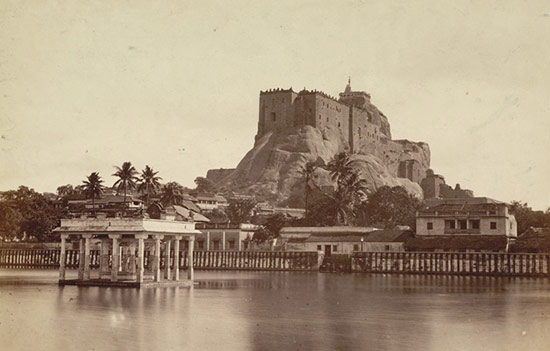 Trichinopoly fort.
Trichinopoly fort.
After death of Chhatrapati Shahu, Murarrao
tried to maintain his semi-independent position by allying with other Karnataka
Chiefs like Savnur Nawab but in 1756 during the attack on Savnur, Nanasaheb
Peshwa brought him back to the Maratha fold.
Campaigns
against Hyder
During the 1764 Maratha campaign against Hyder Ali under Madhavrao Peshwa, Murarrao excelled again. In the battle of Anawadi and Rattehalli, the forces under Murarrao effectively blocked the attempt of a surprise attack by Hyder on the Marathas. Even under murderous fire, Murarrao’s forces stood their ground till the reinforcements from Maratha Huzurat (Household troops) under the personal command of Madhavrao came to support him.
In the 1767 campaign against Hyder,
Murarrao played a crucial role. Madhavarao Peshwa captured Madgiri fort, and released
the erstwhile king and the dowager queen of Bidnur imprisoned there by Hyder. Maratha
forces took Channanaryandurga, Chik Balapur, Dod Balapur, and forced Hyder to sue for peace, the condition being
transferring this area to the Marathas and paying war indemnity of 31 lakhs.
However, Hyder soon started to foment trouble and in late 1769 Madhavrao had to open a new campaign against him. In this campaign, Murarrao’s forces subdued areas and forts like Devanhalli and Magadi. In June 1770, when intelligence was received that Hyder’s forces were planning to capture the fort of Chik Balapur, Murarrao marched 80kms in a day and helped thwart the attack.
In the famous Battle of Moti Talav, Hyder was waiting on a plain immediately after a mountainous pass with an intent to restrict movement of Maratha cavalry. But Murarrao and his nephew Anandrao’s forces made a furious cavalry charge and after desperate fighting captured all the guns. The Maratha attack was so destructive that
Hyder was barely able to escape with only 14 horsemen. Many of his troops surrendered by ‘literally keeping twists of straw between their teeth’ reported Trimbakrao Pethe, the C-in-C. The siege of Srirangapatana was the final straw and Hyder had to pay Rs.50 lakhs as a tribute to Marathas.
After death of Madhavrao, the Maratha court was divided between Raghunathrao and Barbhai (the council of twelve ministers) factions. Barbhai was formed to protect the young son of Narayanrao Peshwa, known as Sawai Madhavrao, from the intrigues of Raghunathrao and thwart the British designs for Maratha Empire. In this scenario, the Karnatak front became secondary.
The
siege of Gooty
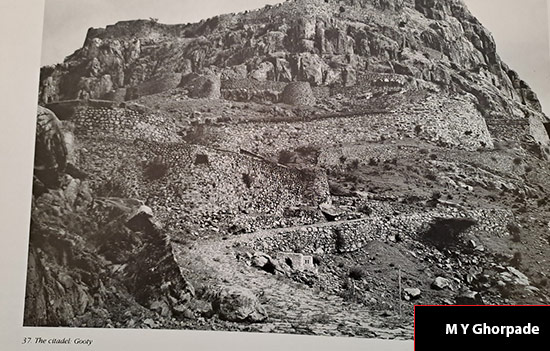 Gooty Fort. Credits 1.
Gooty Fort. Credits 1.
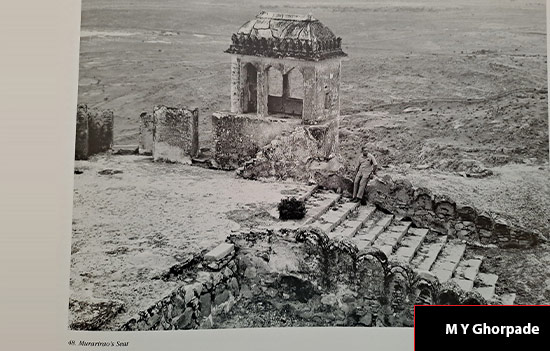 Murarrao’s seat. Credits 1.
Murarrao’s seat. Credits 1.
Hyder Ali seized the moment and marched against Murarrao. After sending the families to the safety of Madkashira fort, Murarrao planned to resist Hyder at Gooty fort. When Hyder sent message that Murarao has to return his guns and pay Rs. 1 lakh as a token of his submission, then 71 years old Murarrao sent a memorable reply ‘as a Senapati, I’m in habit of levying the tribute, not paying it’, which enraged Hyder further.
The siege started in December 1775. For the next three months every attack by Hyder was beaten back by Murrrao but in March 1776, the water shortage in the fort became acute. Negotiations were soon started and Murarrao tried to keep numbers limited in the fort so as to use the limited water judiciously.
To convince Hyder for negotiations he paid
6 lakhs in jewelry and sent some influential persons to him as hostages. Pale
Khan, one of them accidentally revealed the water shortage in the fort and
Hyder promptly broke off the negotiations by accusing that the actual valuation
of jewels was only 60000 (1/10th). In a show of defiance, when Murarrao sent next 12 boxes of supposed jewelry, Hyder found out that they contain, ‘gravel, broken tiles and slippers discarded by the dancing girls’.
Maddened with rage, Hyder ordered a general attack on the fort, but Murarrao’s forces fought with such bravery that this attack was also beaten with more than 1000 men killed and 2200-2500 of Hyder’s force wounded. The fort garrison was subsisting on uncooked rice and moisture from scraped, wet mud, still they resisted for close to a week. However, the privation of garrison forced Murarrao
to capitulate. He was sent to Kabbaldurg fort near Srirangpatana where he died in captivity in 1777. His death was recorded by contemporary Maratha letter ‘Karnataka is lost today.’
Even after his death the fame of Murarrao was such that when Britishers captured Srirangpatana after killing Tipu, his sword and turban were sent to Cornwallis (EIC Governor) along with Murarrao’s sword as a war trophy.
In the history of the 18th century, Maratha had 3 Rao’s (brave nobles) and Murarrao was one amongst them, the other two being Gopalrao Patwardhan
and Bhavanrao.
To read all
articles by author
To read all
articles on Maratha History
To
read author book on Aurangzeb
References
1. The Grand Resistance
by M. Y. Ghorpade published by Ravi Dayal.
2. Santaji: Kaka
Vidhate published by Prafullata Prakasan.
3. 18th
Century Maratha General in the South- P.L. Saswadkar
4. Maasir-i-Alamgiri-
Saqi Mustaid Khan
5. Muntakhabu-l-Lubab-Khafi
Khan
6. Marathi
Riyasat- G.S. Sardesai
7. Historical
Genealogies: G.S. Sardesai
Photograph
Credits
1. The Grand
Resistance by M. Y. Ghorpade published by Ravi Dayal.
2. Santaji: by Kaka
Vidhate published by Prafullata Prakasan.
Pictures copyright with author of book and publisher. These should not reproduced without publisher / author permission.
The couplet at the starting of the article is loose translation of a Marathi couplet on Santaji.
Also
read
1. Patwardhans – Sword arm of the Peshwai
2. The
Return of Queen Yesubai